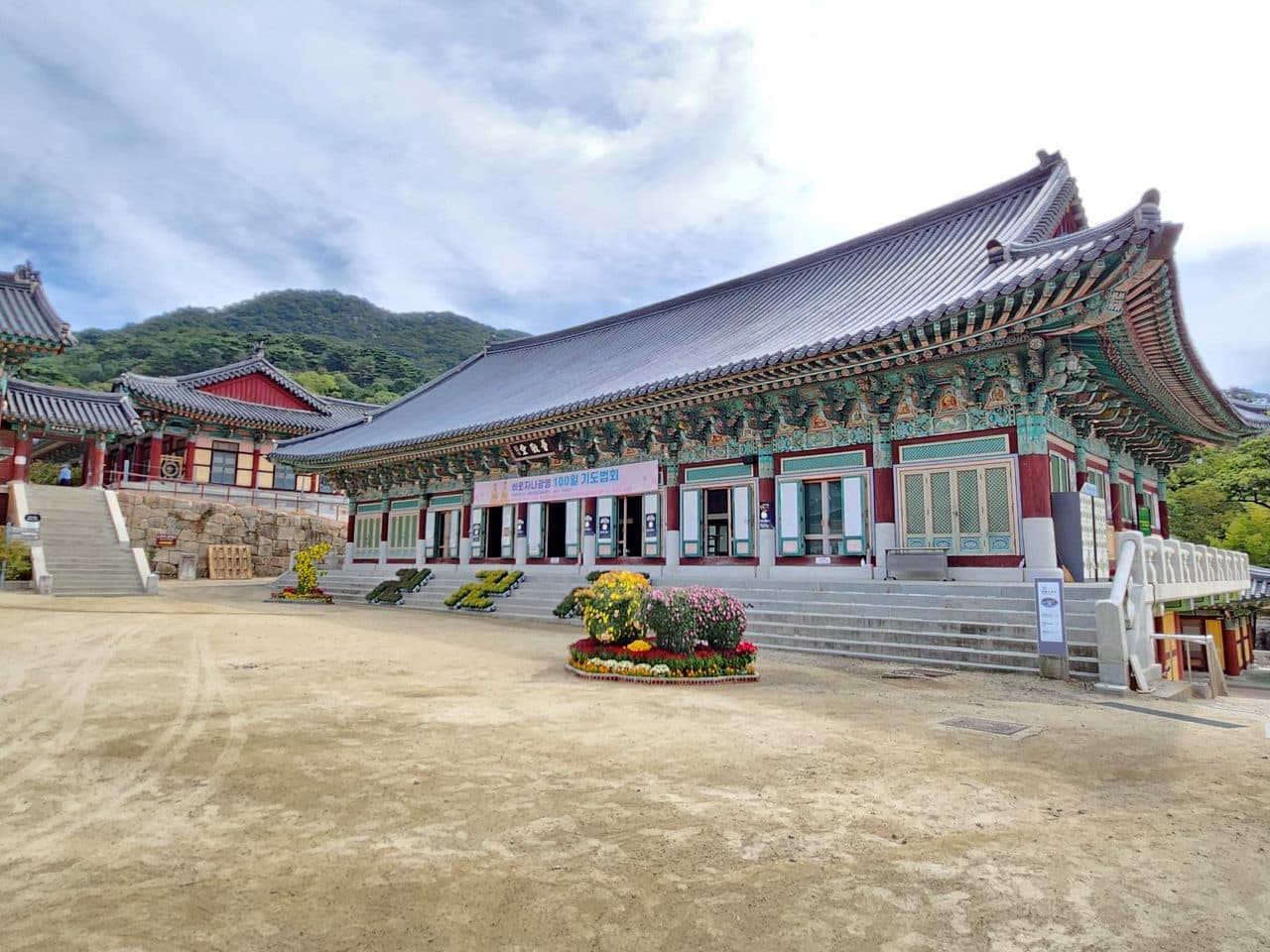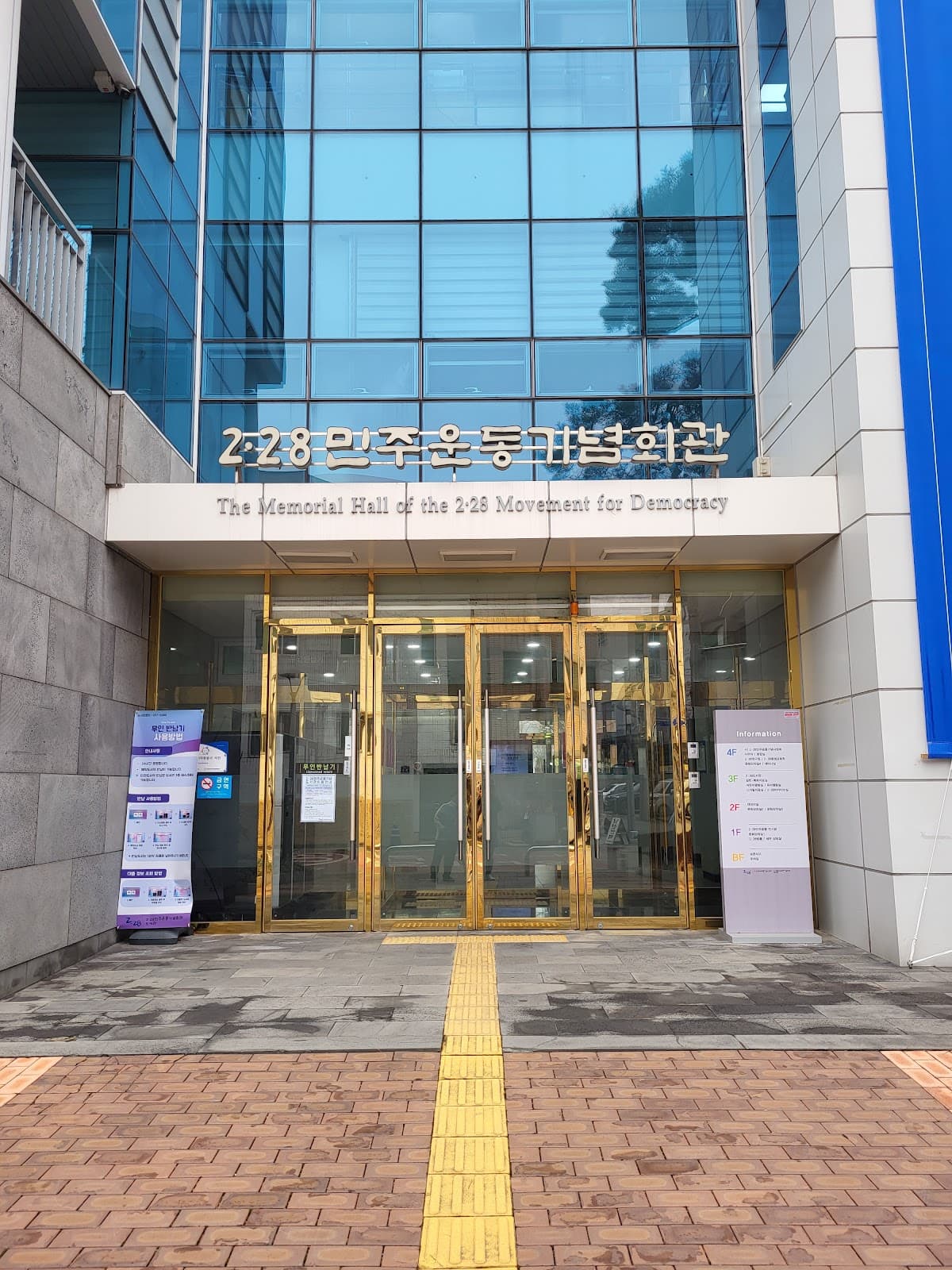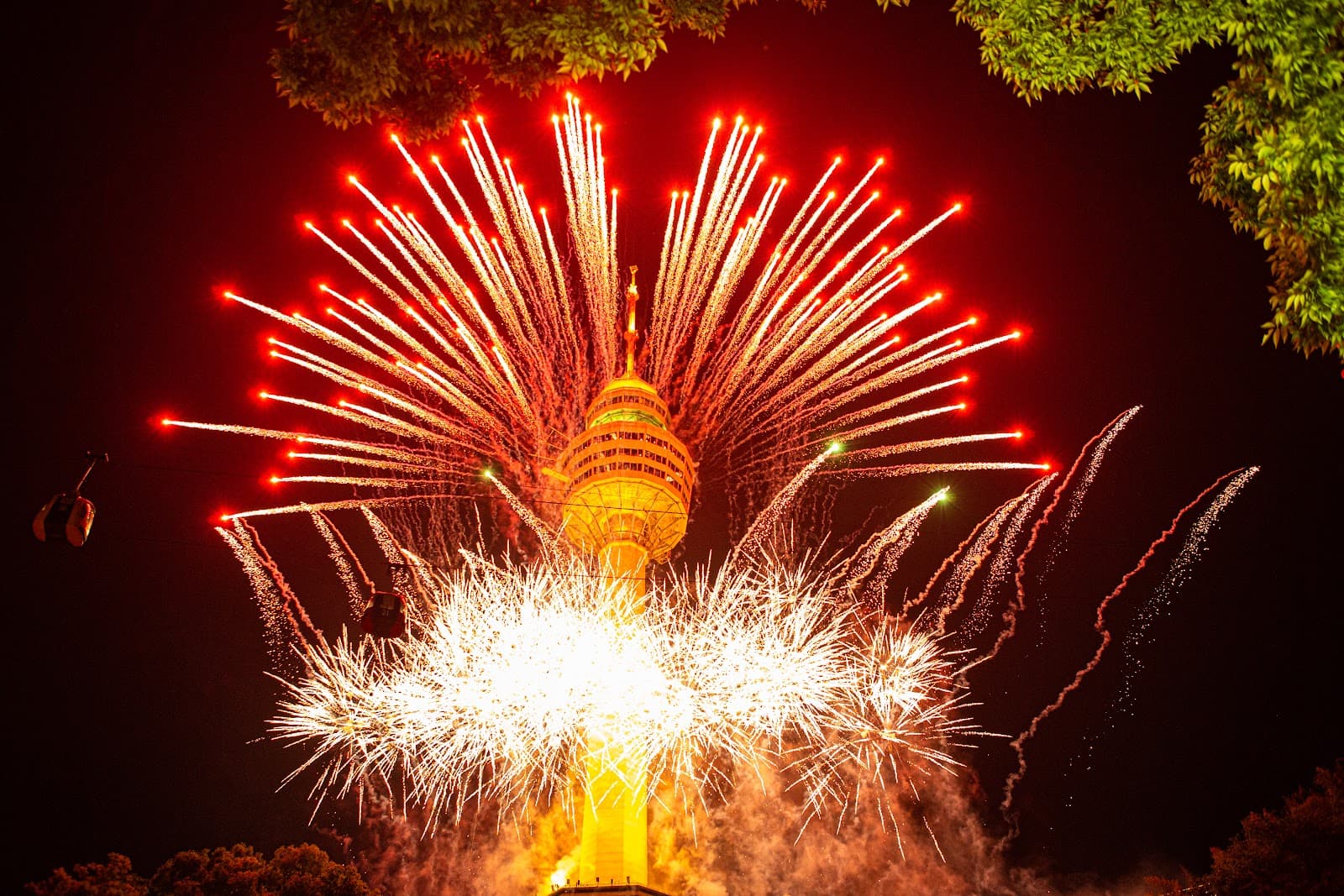
Gayasan National Park
Remote, mountainous park preserving Korean history with stunning hiking trails and the significant Haeinsa Temple.
Highlights
Must-see attractions

Social
From TikTok & Reddit
Best Time
Fewer crowds, peaceful hikes

Gayasan National Park
Best Time
Fewer crowds, peaceful hikes
Highlights
Must-see attractions
Remote, mountainous park preserving Korean history with stunning hiking trails and the significant Haeinsa Temple.
"An excellent hike and beautiful National Park with lots of natural beauty and hikes."

Choose Your Hike Wisely
Opt for the 'normal' or 'easier' courses if you're not an experienced hiker. :hiking_boot:
Check Course Opening Times
Expert courses may open later (9 AM) from Nov-Mar. Plan accordingly! :clock1:

Highlights
Discover the most iconic attractions and experiences

Manmulsang Course
Rocky mountain trails
Experience breathtaking rocky terrain and stunning natural formations on this popular and rewarding hiking trail.

Haeinsa Temple
Within the park
Discover a significant historical site preserving Korean heritage, nestled amidst the park's natural splendor.

Scenic Mountain Views
Various viewpoints
Immerse yourself in the vast mountainous landscapes that make Gayasan a memorable destination for nature lovers.
Plans like a pro.
Thinks like you
Planning Your Visit
Timing Your Visit to Gayasan
Hiking Trails & Difficulty
Best Times
Insider Tips
from TikTok, Instagram & Reddit
Choose Your Hike Wisely
Opt for the 'normal' or 'easier' courses if you're not an experienced hiker. :hiking_boot:
Check Course Opening Times
Expert courses may open later (9 AM) from Nov-Mar. Plan accordingly! :clock1:
1 month itinerary help
Embrace the Scenery
Take your time to enjoy the natural beauty and unique rock formations. :camerawithflash:
Stay for More Than an Afternoon
There's plenty to explore; consider a longer visit to fully appreciate the park. :briefcase:
Tips
from all over the internet
Choose Your Hike Wisely
Opt for the 'normal' or 'easier' courses if you're not an experienced hiker. :hiking_boot:
Check Course Opening Times
Expert courses may open later (9 AM) from Nov-Mar. Plan accordingly! :clock1:
Embrace the Scenery
Take your time to enjoy the natural beauty and unique rock formations. :camerawithflash:
Stay for More Than an Afternoon
There's plenty to explore; consider a longer visit to fully appreciate the park. :briefcase:
What Travellers Say
Reviews Summary
Visitors praise Gayasan National Park for its stunning natural beauty, particularly the rocky Manmulsang hiking course, and the historical significance of Haeinsa Temple. Many appreciate the diverse hiking options, from easy to challenging. Some note that certain trails can be demanding, and seasonal opening times for specific courses should be checked.
"An excellent hike and beautiful National Park. If taking the expert course, be advised it doesn't open until 9am from November until March, so if you arrive early take the other course up and come down the expert course. Lots of cool rock faces."
Riley Maw
"Really beautiful place. Only spent the afternoon there, but could easily stay much longer. Lots of natural beauty, hikes, and some shops and restaurants too."
William T
"I've been on a normal course, but it's never easy. Good luck ~"
Jaepeel Kim
What People Like
What People Dislike
Frequently Asked Questions
🚇 🗺️ Getting There
To reach Gayasan National Park from Busan, you'll typically need to take a bus. Look for intercity buses heading towards the park's entrance or nearby towns like Hapcheon. The journey can take a few hours, so it's advisable to check bus schedules in advance. Some travelers suggest combining a visit with other nearby attractions if time allows, though Gayasan itself warrants dedicated exploration.
Once you arrive at the park, walking is the primary way to explore the main attractions like Haeinsa Temple and the hiking trails. Public transportation within the park is limited, so be prepared for some walking. Consider comfortable footwear as many visitors enjoy hiking through the park's terrains.
Yes, a day trip to Gayasan National Park is possible, especially if you focus on key areas like Haeinsa Temple and a shorter hiking trail. However, many visitors recommend staying longer to fully appreciate the park's natural beauty and hiking opportunities.
Getting to Gayasan National Park from Seoul usually involves taking a KTX train to a major city like Daegu or Jinju, and then transferring to a bus that goes towards the park. This multi-leg journey requires some planning but is a common route for exploring national parks in Korea.
Information on internal shuttle buses can be limited. It's best to check locally upon arrival or consult park information centers for any available transport options within the park itself, especially if you plan to access more remote trailheads.
🎫 🎫 Tickets & Entry
While the park itself is generally accessible, there might be fees associated with specific attractions within the park, such as Haeinsa Temple. It's always a good idea to check the official park website or inquire locally for the most up-to-date information on entrance fees and any associated costs.
Gayasan National Park is typically open year-round, but specific attractions or hiking trails may have their own operating hours. For instance, some hiking courses, like the 'expert' ones, might have adjusted opening times during certain seasons, such as opening at 9 AM from November to March.
For general park entry, advance booking is usually not required. However, if you plan to visit specific cultural sites within the park, like Haeinsa Temple, it's wise to check their individual ticketing policies. For popular hiking trails, arriving early is often recommended rather than booking.
Typically, national parks in Korea do not charge per trail. Entrance to the park is usually a general fee, if any, and specific sites like temples might have their own admission. Hiking trails themselves are generally free to access once inside the park.
Entrance fees, if applicable, are usually payable in cash at designated ticket booths. For temple admissions, they may also accept cash. It's always a good practice to carry some Korean Won with you for smaller payments.
🎫 🏞️ Onsite Experience
The Manmulsang course is highly recommended for its rocky terrain and scenic beauty. Visitors also mention enjoying 'normal' or 'easier' courses if they prefer less strenuous hikes. Be aware that 'expert' courses might have specific opening times.
Hiking difficulty varies. While some trails are described as 'never easy,' there are also easier options available. The Manmulsang course is noted for being rocky. It's advisable to choose a trail that matches your fitness level and experience.
Comfortable hiking shoes or sturdy athletic shoes are essential, especially for the rocky trails. Layers of clothing are recommended as mountain weather can change. Don't forget sun protection and water, especially during warmer months. :athletic_shoe:
Yes, you can expect to find restrooms and rest areas, particularly near the main entrance, Haeinsa Temple, and at the start of popular hiking trails. It's always a good idea to utilize these facilities when available, as they might be spaced out on longer trails.
As a national park, Gayasan is home to various flora and fauna. While sightings can vary, you might encounter birds, small mammals, and diverse plant life. Respecting wildlife and maintaining a safe distance is always encouraged.
🍽️ 🍽️ Food & Dining
Yes, there are usually shops and restaurants located near the park entrance and around Haeinsa Temple, offering various Korean dishes. These options provide convenient places to eat after hiking or exploring.
You can typically find traditional Korean cuisine, including rice dishes, stews, and local specialties. It's a good opportunity to try authentic Korean flavors.
Packing a picnic is a great idea if you plan to spend a full day hiking or want to enjoy a meal amidst nature. There are often designated picnic spots, or you can find a scenic location to relax. Remember to pack out all your trash. :sandwich:
While traditional Korean cuisine can be meat-heavy, many restaurants offer vegetarian options like bibimbap (without meat) or vegetable side dishes. It's advisable to communicate your dietary needs clearly when ordering.
Prices for food in national park areas can be slightly higher than in city centers. Expect to pay a moderate price for meals, similar to casual dining in other tourist spots in Korea.
📸 📸 Photography
The Manmulsang course offers dramatic rock formations and panoramic views, making it a prime spot for photography. Haeinsa Temple also provides beautiful architectural shots. Look for scenic overlooks along hiking trails for stunning landscape photography.
The 'golden hours' – shortly after sunrise and before sunset – offer the most flattering light for landscape photography. Midday can be harsh, but it's still great for capturing the details of rock formations and temple architecture.
Drone usage in national parks is often restricted to protect wildlife and ensure visitor safety. It's crucial to check the park's official regulations regarding drone operation before flying one.
A versatile lens, such as a wide-angle for landscapes and a mid-range zoom for details, is recommended. A sturdy tripod can be beneficial for low-light conditions or capturing long exposures of the scenery. :camerawithflash:
Photography rules can vary within temples. Generally, photography is allowed in outdoor areas and main halls, but it might be restricted inside certain sacred chambers or during specific ceremonies. Always look for signage or ask temple staff.
For Different Travelers
Tailored advice for your travel style
👨👩👧 Families with Kids
Consider focusing on the areas around Haeinsa Temple for a mix of cultural exploration and gentle walks. The natural scenery itself is engaging for kids, and the chance to see a historic temple can be educational. Ensure children have appropriate footwear and are supervised closely on any trails. Packing plenty of snacks and water is always a good idea for family outings.
🚶 Solo Travelers
Consider visiting during weekdays to enjoy a more solitary experience on the trails. The park offers ample opportunities for reflection and photography. Don't hesitate to ask park staff or locals for recommendations on trails or points of interest if you need guidance.
⛰️ Avid Hikers
Research the 'expert' courses and their specific opening times, especially during off-peak seasons. Combining multiple trails or exploring less-trafficked routes can offer a more extensive hiking adventure. The park's mountainous landscape provides a great workout and breathtaking vistas for dedicated trekkers.
Deep Dives
In-depth insights and expert knowledge
Exploring the Trails of Gayasan
It's important to note that some trails, particularly the 'expert' courses, may have specific opening hours, sometimes starting later in the morning during colder months (e.g., 9 AM from November to March). Always check the latest information before heading out. Wearing appropriate hiking footwear is crucial due to the rocky nature of many paths, and bringing plenty of water and snacks is advisable for longer treks.
Beyond the popular hiking routes, the park's natural beauty extends to serene valleys and streams, offering opportunities for peaceful walks and nature observation. The combination of challenging climbs and accessible paths makes Gayasan National Park a compelling destination for hikers of all abilities.
Haeinsa Temple: A Historical Gem
Visiting Haeinsa Temple offers a profound glimpse into Korean history and Buddhist culture. The temple complex itself is architecturally impressive, with traditional Korean temple buildings set against the backdrop of the park's natural splendor. Visitors can explore the various halls, pagodas, and courtyards, soaking in the spiritual atmosphere. Photography is generally permitted in outdoor areas, but it's always wise to respect any restrictions within sacred spaces.
The temple's historical importance and its serene setting make it a must-visit for anyone exploring Gayasan National Park. It provides a cultural counterpoint to the park's natural attractions, offering a deeper understanding of Korea's rich heritage.
Planning Your Gayasan Adventure
For those interested in the 'expert' hiking courses, be mindful of seasonal opening hours, which might differ from general park access. It's also wise to research the difficulty of hiking trails beforehand to select routes that align with your fitness level. While some trails are challenging, many visitors find the 'normal' or 'easier' courses to be very enjoyable and scenic.
Remember to pack essentials like comfortable footwear, water, and snacks. While there are dining options near the park entrance and Haeinsa Temple, having your own provisions can be convenient, especially if you plan on extended hikes. Checking local weather forecasts before your trip is also recommended.






Social
from TikTok, Instagram & Reddit